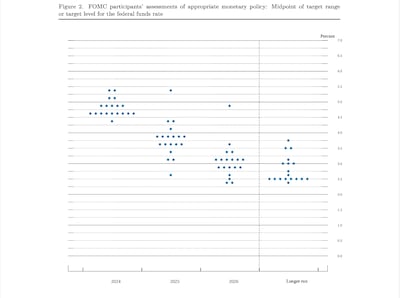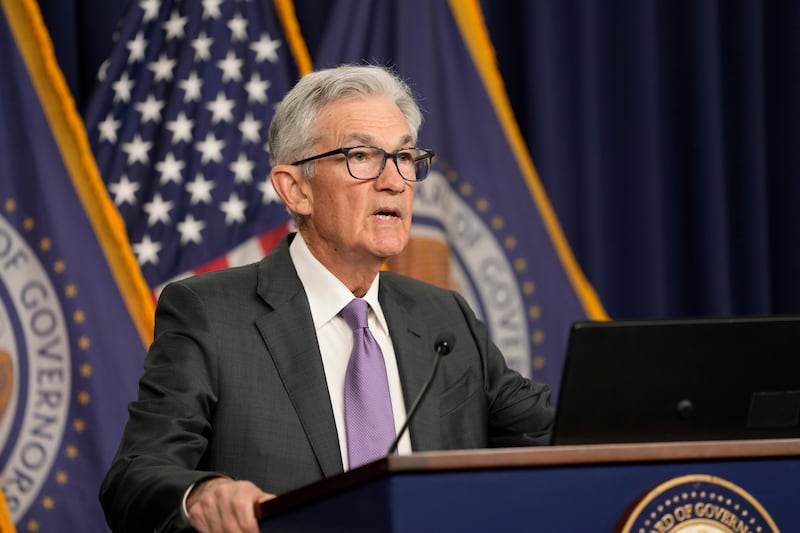The Federal Reserve anticipates it will cut US interest rates three times this year after leaving its target range unchanged at 5.25 to 5.50 per cent.
“If the economy evolves broadly as expected, it will be appropriate to begin dialling back … at some point this year,” Fed Chair Jerome Powell told reporters.
“The committee does not expect it will be appropriate to reduce the target range until it has gained greater confidence that inflation is moving sustainably towards 2 per cent,” he said.
In its so-called dot plot, which forecasts where rates will eventually land, Fed officials pencilled in three quarter-rate cuts for this year.
The figure showed that interest rates will fall to 4.6 per cent by the end of 2024, in line with their December projections.
The dot plot will again be closely watched by traders, who believe the Fed will begin cutting interest rates in June, CME Group data shows.

But Fed officials also slightly raised their rate forecasts for the years ahead, suggesting a slower approach in bringing down rates.
The Fed's benchmark rate is estimated to fall to 3.9 per cent by end of 2025 and 3.1 per cent by end of 2026.
Mr Powell also said it is unlikely the Fed will return to pre-pandemic rates, which were at a near-zero.
“We do not read too much into this as there is considerable uncertainty in interest rates next year, particularly as the outcome of the election will have significant implications for the economy and the path of monetary policy,” Oxford Economics chief economist Ryan Sweet said in a note.
“However, the belief that fewer cuts are needed next year likely suggests that the central bank is assigning a higher probability of a soft landing.”
Mr Powell did not offer a time for when cutting rates may begin, but said the Fed will be specifically looking at incoming inflation data to find the necessary confidence to begin cutting rates.
“Of course we'll also be looking at all the other things that are happening with the totality of the data … but the most important thing will be the inflation,” he said.
Mr Powell added that inflation data this year suggests “we were right” to wait on cutting rates.
Other central banks were also expected to closely monitory the Fed's decision and Mr Powell's press conference.
The UAE and Saudi Arabia, whose central banks follow the Fed's lead, have also increased their borrowing costs since 2022. Meanwhile, the European Central Bank is projecting confidence that it could begin cutting its rates in June.
Shortly after the Fed's decision, the Central Bank of the UAE announced that it had also maintained its interest rates at 5.4 per cent.
Stubborn inflation and mixed data
This week's Fed meeting came after a series of mixed economic data highlighted the US central bank's bumpy path back to its long-term 2 per cent inflation target.
The most stubborn issue for the Fed is inflation itself. The Consumer Price Index came in slightly higher than anticipated in February, increasing 3.2 per cent annually, a slight increase from 3.1 per cent a month earlier.
Core CPI – which excludes food and energy – also came in higher than estimations.
The Fed's preferred inflation metric, the Personal Consumption Expenditures Price Index, posted monthly increases for both headline inflation and core inflation.
Wholesale inflation also rose, the Labour Department reported last week.
“We didn't excessively celebrate the good inflation rates we got in the last seven months of last year … and we're not going to overreact as well for these two months,” Mr Powell said.
Wholesale inflation also rose, the Labour Department reported last week.
While the economy added 275,000 jobs last month, there were encouraging signs for the Fed as wage growth cooled. Meanwhile, the unemployment rate slightly increased to 3.9 per cent, still low by historical standards.
The latest data highlights the challenges the Fed faces, which Mr Powell has acknowledged. Keeping rates elevated for too long could steer the economy into a recession while cutting them too soon could stall the progress the Fed has made.
“We want to be careful,” Mr Powell said.
Fed not far from slowing pace of shrinking balance sheet
Mr Powell also said the Fed is not far from starting to slow the pace of its balance-sheet run-off.
“It will be appropriate to slow the pace of run-off fairly soon,” he said.
The Fed said it would continue to reduce its holdings of Treasury securities and mortgage-backed securities, a process otherwise known as quantitative tightening, or QT.
Along with interest rates, QT is one of the tools the Fed uses to heat up or cool down the economy.
The Fed began increasing the size of its balance sheet to support the economy at the onset of the Covid-19 pandemic through a process known as quantitative easing.
It has begun shrinking the size of its holdings since the summer of 2022 after its assets hit a peak of almost $9 trillion.
Mr Powell said the Fed's security holdings have declined by about $1.5 trillion to its current $7.5 trillion.
“In particular, slowing the pace of run-off will help ensure a smooth transition, reducing the possibility of money markets experiencing stress,” he said.
Mr Powell also said a slower pace would allow for a smoother transition that would create less risk of liquidity problems “which can grow into shocks”.
“It's sort of ironic that by going slower you can get farther, but that's the idea,” he said.
Mr Powell said the Fed's longer-term goal is to eventually have “mostly” Treasuries on its balance sheet instead of mortgage-backed securities.








